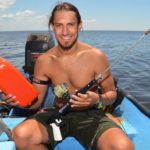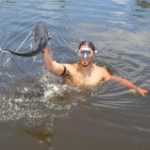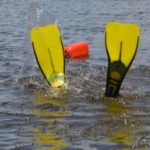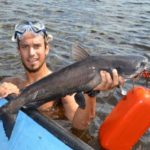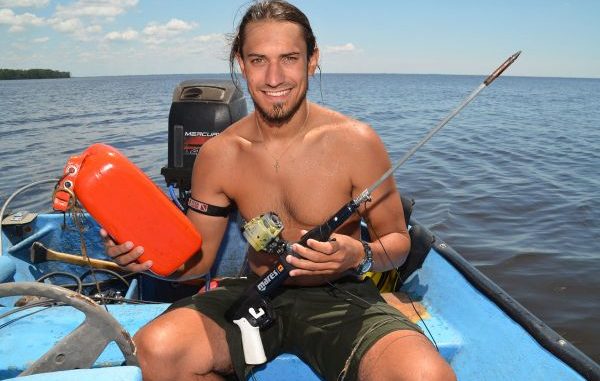
Lake Maurepas isn’t on most people’s go-to water ways, but it’s packed with catfish. And this Pontchatoula native can often be found diving into the lake to do up-close battle using only a spear gun.
The story of the old bull and the young bull is almost cliché.
If somehow you haven’t heard it, do a web search for “The old bull and the young bull.” The venerable parable is supposed to be thought-provoking.
But it was obviously written by an old bull in the vein of making being old somehow having value.
Maybe sometimes it does.
But what I was part of on this day was a young man’s game.
Jacob Griffin explosively surfaced from the tea-colored water, blowing like a spouting whale. Firmly gripped in his hand was another Lake Maurepas blue catfish.
He had been diving for over five hours.
That takes a lot.
Earlier in the day, Griffin launched his 16-foot lake skiff into the Natalbany River in Springfield. The water looked druggy, but the scenery was stellar. Most of the river flowed through a picturesque cypress-tupelo swamp, although the first part of the ride was marred by a man-made blight of $500,000 waterfront homes.
But soon enough all that was left behind, and the looping river was flanked by a solid mass of vibrant green trees bordered above by cobalt skies and below by the black river waters.
As the skiff neared Lake Maurepas, the solid stand of trees gave way to open swamp broken by marsh.
His plan was to enter the lake at its northern end and run the west bank southward, searching for water clear enough to dive. A very late front had blown from the northwest enough for him to assume that the lake’s water would be dingy.
Successfully spearfishing the big lake demands certain conditions.
“It should be calm, calm, calm,” Griffin said as he shook his head. “You need clear water. Wind or too much rain stir the water up.”
He added that the more sun that was present the better. Best diving light occurs between 10 a.m. and 3 p.m., which explained our leisurely 9:30 a.m. start.
As for clouds, he grimly made a throat-cutting motion, before amending the gesture to say that under swimming pool-clear conditions some clouds can be present, but not when the water is stained tannic brown as it was today.
Griffin scowled when the skiff entered the lake. The water was distinctly dingy — greenish-brown with suspended sediments giving it an almost chalky tinge.
When conditions are right, from sometime in May to early September, he spearfishes the lake three days a week. By his estimate 55 to 60 days a year.
Ninety percent of his catch is blue catfish, with the remainder being Opelousas (aka yellow) catfish.
He never dives alone, for obvious safety reasons.
The best day he ever had was when a three-man dive party speared 36 fish. His personal best to date is a 38-pound blue catfish.
The thought of a huge catfish on the other end of a spear gun hauling me through tree stumps made me cringe. I asked him what he would do if he saw a 100-pounder.
Visibly excited, he quickly answered.
“I’d shoot it!” Griffin said.
As he ran the lake’s shoreline southward a hundred or so yards out from the bank to search for suitable diving water, he explained how he got hooked on this gig.
“When I was 13, I hopped in a boat of spearfishermen heading to Lake Pontchartrain just for the ride. I had already heard about (spearfishing catfish); I think it’s a local thing.
“It blew my mind. I dove for about three minutes. I loved it. It’s crazy; it’s completely different underwater. It was so odd, but so real.
“I was still only 13 when a friend, Corey Dufreche, began to bring me on trips. I had already bought my own gear. When I started to drive at 16, I went on my own with friends. They were already experienced at diving.”
He described his main partner and best friend Rob Van Vrancken as a “killer.” His other diving regulars include Dustin Rhodes, Gaige Jones and Laramie Hill.
Water clarity gradually improved as Griffin traveled southwesterly. Just after passing the mouth of the Amite River, he idled the boat nearer to the lake’s bank and dropped the anchor. The water here, while not up to his ideal standards, was deemed worth a look.
“Where’s my toothpaste,” he mumbled to himself as he grabbed his goggles.
He placed a dollop of the dentifrice (any brand is fine, he said) on the inside of each lens. He used his fingers to smear it over the lens’ inner surfaces, and then rinsed them clean in the lake’s water. This process keeps the lens from fogging over when colder lake waters hit them, he explained.
While he was rigging up, Griffin talked about what to look for besides clear water.
“Look for old cypress stumps,” he said. “You can’t go by what’s on the surface. You find them by diving to the bottom and swimming around.
“There are a lot more stumps and laydowns near the lake’s bank than farther out. But lots of times the fish aren’t in shallow depths.”
Griffin does most of his spearfishing in water between 3 and 10 feet deep. The presence of stumps rooted in the bottom in 10-foot-deep water gives pause to wonder: Just how long ago was that 6 foot diameter stump growing above the waterline?
A seed from a cypress ball will not sprout underwater.
Griffin interrupted my thoughts to continue his lesson on stumps.
“I particularly like to look for stumps with cavities,” he explained. “The best ones are ones you can see daylight through the other side. This allows light for the diver to see into the stump.
“I also dive laydowns. There are lots of yellow cats in those.”
Griffin explained that he fishes the entire lake, but that there are lots of “dead spots,” what he calls open sand bottoms with no stumps.
The best areas, like the one in which he was anchored in, are well known to divers. Sometimes three or four boats of divers will be hunting in one area of stumps at the same time, a fact that didn’t seem to bother him a bit.
Personal rigging done, he cocked his gun by pushing the point of the spear against the side of the boat and promptly tossed it overboard to prevent having to enter the water with a loaded gun in his hand. Once in the water, he swam to the buoy, retrieved the gun and began the hunt.
He arched his back to dive and his fins came out of the water like a whale’s flukes. He swam rapidly underwater, with only the buoy trailing on the water’s surface to give his location away.
Periodically he surfaced, explosively blowing spent air from his lungs and immediately inhaling his next breath.
Twenty minutes later, he returned to the boat empty handed. The disappointment was obvious in his voice.
“The water’s just not clear enough here,” he lamented, as he clambered aboard.
He cranked the motor and moved farther down the shoreline. The water became noticeably clearer, and Griffin’s eyes sparkled with excitement.
Short of the mouth of Blind River, on the very western end of the lake, he dropped anchor again and hit the water.
When he was near the surface, I could see him swim through the tea-colored water with an undulating motion. Most of the time, though, he was submerged too deep to be visible.
His confidence was quickly rewarded, and he returned to the boat with a 5-pound blue catfish — the first fish of the day.
Without leaving the water, he reached over the gunnel and tossed the fish in the ice chest, and was off on the hunt again.
The day was beautiful, with a soft lazy breeze caressing me in the boat. A bullfrog ba-rumped from the green jungle in front of me. Behind me lay the huge expanse of the lake, not another boat in sight.
The only human sounds were from Griffin himself, exhaling and gulping fresh air into his lungs, and then the soft splash of his dives as submerged headfirst.
Periodically, he shouted updates on each fish he approached.
He was excited. A far cry from the somber, concerned-looking man staring at the dull waters of the lake a few hours ago.
“The water’s great here! We’re going to kill some fish!” Griffin called.
After two hours of exertion, he approached the boat. He climbed in, shed his gear and sat dripping in the sun, obviously tired. He declared that he was going to move the boat closer to the mouth of the river and take a break.
“I like to keep my diving in a day to three or four hours,” Griffin said. “That way it doesn’t kill you for the next day. Diving is strenuous.”
After another two hours of diving, Griffin returned to the boat with his fish and clambered aboard. Just thinking about the physical stress put on his body after so much diving, made my muscles ache.
It didn’t seem to bother him, though. He smiled all the way back to the boat landing. In the truck, he began to softly sing country music.
